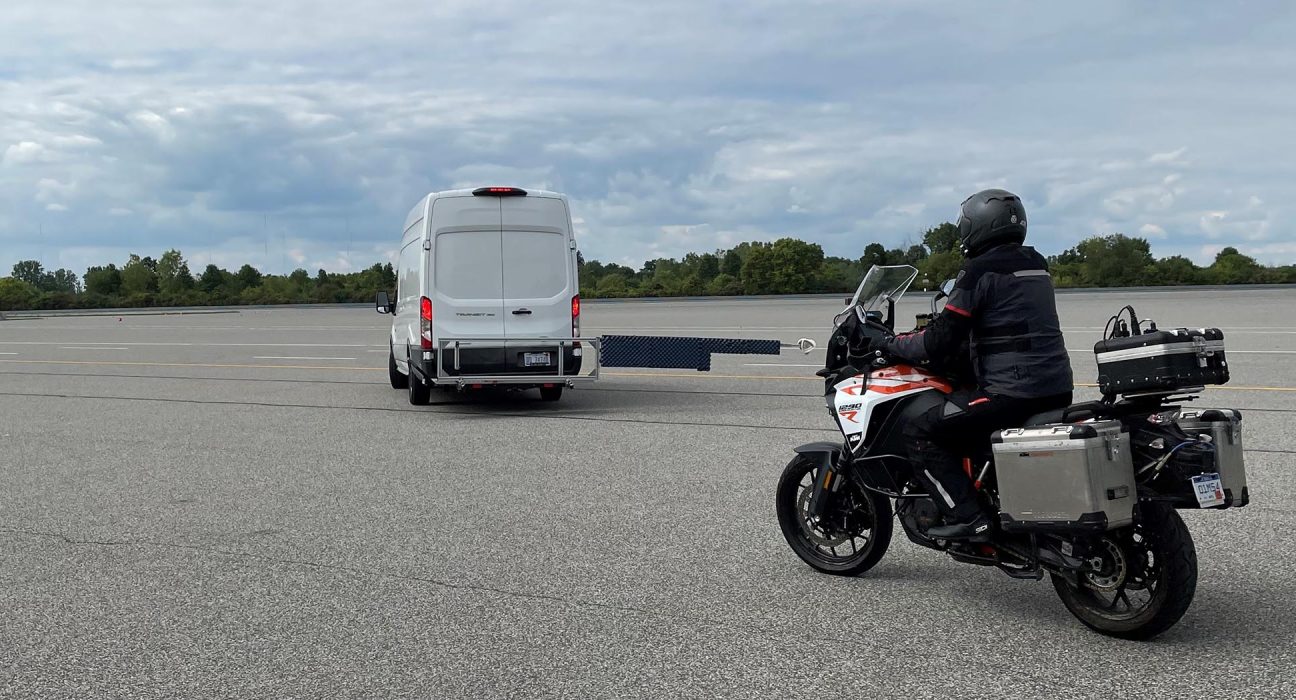Checking in with Bosch and its advanced Forward Collision Warning System technology
January 25, 2023
By Michael Sayre
NOTE: This story first appeared in the December 2022 issue of American Motorcyclist
It is an unfortunate fact of our two-wheeled life that many motorcyclists involved in crashes — almost a third of them, in fact — took no evasive action to avoid the crash or did so too late to effectively avoid them. This statistic comes from the 2018 National Transportation Safety Board report on the causes of motorcycle crashes, which used data from the Hurt Report and more recent Motorcycle Crash Causation Study.
Rider education and on-road experience stress the need for motorcyclists to pay strict attention to the road ahead and do their best to avoid dangerous situations before they occur. But motorcyclists are human, and distractions and/or a lack of road skills can and do rear their ugly heads on occasion.
So what can be done to draw the riders’ attention back to the road ahead when, for instance, a car turns left in front of them or when traffic suddenly stops?
In the automotive world, several different features have hit the road under the umbrella of Advanced Driver Assistance Systems (ADAS), which are advertised as safety features. And while the AMA is extremely skeptical of technologies that have not demonstrated their ability to properly detect and respond to motorcyclists on the road (and most have not), potential benefits remain. The dreaded “left turning car,” for instance, which kills a lot of riders each year, could become a thing of the past, but only if our motorcycles are seen by these systems.
What is newer than the automotive world’s ADAS is Advanced Rider Assistance Systems (ARAS) coming to more and more motorcycle models. In 2019 I was able to try out Adaptive Cruise Control and Blind Spot Monitoring systems on a motorcycle at Bosch’s Proving Grounds in Flat Rock, Mich., and write about the experience in the October 2019 issue of American Motorcyclist.

This September I was fortunate once again to visit the Bosch facility and get a peek at how those systems are evolving — and get a small glimpse at what else may be coming to a motorcycle near you.
I grew up near Bosch’s Flat Rock Proving Grounds and have kept in touch with the engineers of the company’s Two-Wheeler & Powersports division there, and anytime I’m planning a trip to see friends and family back home, I check in with techs there to get a feel for what they’re working on. This time it was a Forward Collision Warning System (FWCS) for motorcycles.
The engineers told me that since they have successfully integrated front and rear radar on motorcycles for Blind Spot Monitoring (BSM) and Adaptive Cruise Control (ACC), they’re working out what else can be done with the information picked up by the radars. They could only share so much with a visitor like me, but it became clear that FCWS is just a taste of what’s to come.
I should also make clear, because I run into this misconception pretty often, that these engineers are hard-core motorcyclists, not desk jockeys who rarely, if ever, actually ride. Having this sort of real-world experience is important to everyone working on these next-generation systems as they create safer motorcycles that don’t interfere with the ride. That’s the goal.
Now, how do you demonstrate FCWS on a motorcycle? Well, to start with, you have to almost hit something. So engineers attached a rig to the back of a van that held out a small radar target on the van’s right side. The arm holding the target is covered in a radar absorbing foam and holds the target that’s essentially a small, highly reflective mirror. This set up would appear to the radar and “brain” on the bike as a) a van in one lane and b) a bright but very visible object in the lane to the van’s right.
My job was to approach the van and target (which were circling the track at 30 mph) and “almost” hit them. (More on this shortly.) The arm the target was mounted on would swing out of the way if struck.
The FCWS works by probability. If there is an object the rider is approaching while making no effort to avoid striking it, the system will warn the rider. That means to test it I could not touch the brakes, swerve out of the way, or roll off the throttle as I approached the target. Any of those actions would signal to the bike that I was avoiding the object and there was no need to warn me.
The warning I was trying to trigger was actually two warnings: first, a visual warning on the bike’s dash would flash a warning me to brake; second, if I still did not react, the rear brake would pulse three times to get my attention. I was also told that the faster I approached the target, the more time between the warnings there would be, the idea being that at higher closing speeds the more time was needed for the rider to take evasive action.
I don’t know about you, but forcing myself to almost hit something on a motorcycle is not easy, no matter how many times I reminded myself that the target was meant to be hit and would swing out of the way. It took a few runs, but I eventually got comfortable triggering the warnings and then braking before striking the target.
This raised a question: how could I simulate a more “real world” scenario where I would be distracted and not anticipate the warnings? The engineers suggested I stop looking at the target but keep my eyes focused down the track to the point where the target wasn’t really in my line of sight. That worked, and the brake pulse warning went off with enough time for me to brake and avoid the target. Still, I was expecting the warning, and knew exactly what I had to do to avoid the target. Not real world by any stretch, but as close as I was going to get in these conditions.

I was impressed with how well and consistently the system worked. The visual warning on the dash didn’t do much for me, but I can absolutely imagine a situation where a rider is adjusting some setting on the dash when traffic suddenly slows — and that visual warning would get the job done without needing to trigger the rear brake pulse warning.
The brake pulse was very effective; jarring enough to get my attention but not enough to upset the bike or cause me to overreact on the controls. That said, I was prepared for what was coming and had practice with the system in a way that the average rider on the street won’t be able to easily replicate. So I’m hopeful that anyone who rides a bike equipped with this warning system down the road has it explained to them before they get into traffic.
Just as when I tried out ACC and BSM in 2019, I have some questions about FCWS in everyday riding, one of which is how the systems would deal with lane splitting or filtering. Still, my real-world experience with ACC and BSM on my current motorcycle, a Ducati Multistrada V4S that’s equipped with both, has done a great job of making me comfortable with the new technology.
In Washington, D.C., traffic, BSM is a constant reminder to do head checks before switching lanes, and on trips with long stretches of expressway, the ACC is a nice break to shake out my right wrist without constantly adjusting the cruise control to match the speed of traffic.
Of course, one would hope everyday riding wouldn’t provide a lot of experience actually using FWCS. Yet that is how it should be. FWCS is designed to be a safety net, not a regularly used feature — only there to alert an inattentive or surprised rider when a collision is imminent.
Over-reliance on these more advanced automotive-based systems that integrate Automatic Emergency Braking and lane-centering — along with advertising that fails to make the limitations of these ADAS features clear to drivers — is to blame for the dangerous situation we’re seeing on the road today, where tragic crashes resulting from car drivers’ overconfidence in the capability of their car to react to traffic, or increased distraction from cars that do most of the driving task, happen all too often.
Is all this ADAS-enabled bad driving behavior coming to motorcycling with ARAS? For now, I don’t see it. What I see with FCWS is a chance to get the almost one third of riders who took no evasive action before a crash to wake up and avoid that crash. What the rider does once he or she has been warned is up to them and their skill level, and according to the NTSB report mentioned in the beginning, just under a quarter of riders chose the appropriate evasive action and executed it properly.
But this is clearly a step in the right direction.
As we know, there is no silver bullet for motorcyclist safety, and safer motorcycles are only part of the equation. Safer roads, improved rider skills, and awareness of motorcyclists on the road are all part of the equation that can prevent some crashes and mitigate the severity of others. The AMA is hard at work on all this: ensuring roads are safer for motorcyclists, helping push advanced vehicle technology that actually protects motorcyclists, and making sure motorcyclists have access to affordable and quality rider training.
I am looking forward to my next visit to Bosch to see what comes next, but my advice to you is this: be aware at all times and practice emergency braking regularly; you never know when you’ll need those skills.
Michael Sayre is the AMA Director of Government Relations






